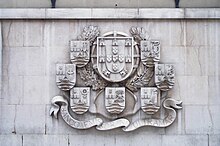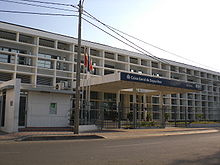Banco Nacional Ultramarino
The Banco Nacional Ultramarino ( National Overseas Bank ) is a Portuguese bank that mainly operates in the former colonies of Portugal. She is a subsidiary of the Portuguese public bank Caixa Geral de Depósitos .
history


The bank was founded in Lisbon in 1864 on the initiative of José da Silva Mendes Leal , Minister for Navy and Overseas Affairs, in order to control the flow of money in the colonies . The bank issued the banknotes of the colonies. The following year, branches were opened in Luanda ( Angola ) and Praia ( Cape Verde ), and in 1868 in São Tomé and Príncipe , Margão ( Goa ) and Mozambique .
In 1901 the BNU lost its monopoly in the colonies, but retained the right to issue banknotes there. A year later, branches were opened in Macau and Bolama ( Portuguese Guinea ). It was not until 1912 that a branch in Dili followed , with which the last Portuguese Timor colony also got an offshoot. A branch was also established in the former colony of Brazil . In 1919 the first stores were in non- Lusophone established areas, namely in Stanleyville (today Kisangani) in the Belgian Congo and French Paris . A branch in Bombay ( British India ) followed in 1920 .
In 1926 the BNU lost its monopoly on spending money in Angola in favor of the newly founded Banco de Angola . In addition, the branch in Stanleyville was transferred to the Banco de Angola. The BNU subsidiary Anglo-Portuguese Colonial and Overseas Bank was founded in London in 1929, and the Paris branch became the Banque Franco-Portugaise d'Outre-Mer subsidiary .
In 1952 the branches in India were closed. In 1965 the BNU, the Banco Português do Atlântico , the Banco de Angola and the South African General Mining founded the Bank of Lisbon and South Africa , later the Mercantile Lisbon Bank . In the 1970s, the BNU bought shares in the Luxembourg Banque Interatlantique and opened an office in London. After the Carnation Revolution , the BNU was nationalized. With the independence of the Portuguese colonies, the BNU lost its importance. In Mozambique, the local government nationalized the parts of the bank there and renamed them the Banco de Moçambique . The same happened in São Tomé and Principe ( Banco Central de São Tomé e Príncipe ) and in Cape Verde ( Banco de Cabo Verde ).
In 1988, alongside the Republic of Portugal, Caixa Geral de Depósitos became the main shareholder of the BNU. In 1991 another branch was opened in London, in 1993 in the Chinese special economic zone Zhuhai . In 1993 Caixa Geral de Depósitos also took over the majority stake in Banque Franco-Portugaise d'Outre-Mer. In 1995 it was agreed with the government of the People's Republic of China that after Macau was returned to China in 1999, the BNU would be allowed to continue issuing banknotes until 2010 in the former Portuguese possession. In 1999 an office was opened in Bombay and Panaji (Goa) and a branch was reopened in Dili, East Timor .
In 2000, the BNU agreed with Macau that the bank would continue to manage the treasury of the Special Administrative Region until 2010. In 2001 the BNU was integrated into the Caixa Geral de Depósitos. The Banque Franco-Portugaise d'Outre-Mer became a daughter of the Caixa Geral de Depósitos. The Macau branch was incorporated by the government of the Special Economic Zone on July 1, 2001 as Banco Nacional Ultramarino SA , but remained a wholly-owned subsidiary of Caixa Geral de Depósitos. In 2002 Caixa Geral de Depósitos also took over the majority of the Mercantile Lisbon Bank of South Africa. Today it is called Mercantile Bank .
Individual evidence
- ↑ Mambu ma Khenzu, E. 2006. A Modern History of Monetary and Financial Systems of Congo, 1885-1995 , Lewiston, New York: Edwin Mellen, p. 132.
Web links
- BNU in Macau (Portuguese / English)
- Banknotes issued by the Banco Nacional Ultramarino in Macau


